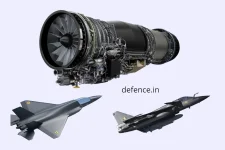- Views: 4K
- Replies: 10
Recent reports surrounding the first flight schedule for India's Light Combat Aircraft (LCA) Tejas Mk2 have caused some confusion, following statements reportedly made by the head of the Defence Research and Development Organisation (DRDO).
Some interpretations suggested a maiden flight could happen very soon. However, reliable sources have stepped in to clarify the situation, confirming that the advanced fighter jet program remains on its previously established timeline.
The confusion appears to have originated from media coverage attributing comments to DRDO Chief Dr. Samir V. Kamat, suggesting the Tejas Mk2's first flight was only "6-12 months" away. This led to speculation that the aircraft might fly as early as October 2025, a significantly faster schedule than anticipated by many in the defence sector. Further investigation indicates these statements may have been misinterpreted or reported out of context.
A key point of misunderstanding seems to be the difference between an aircraft's "rollout" and its "first flight." The rollout, expected between late October and early November 2025, is when the completed prototype aircraft is formally unveiled from the assembly line. This milestone marks the beginning of crucial ground testing, including engine runs and system checks, but not its immediate readiness for flight.
Authoritative sources, including those close to Hindustan Aeronautics Limited (HAL) and the Aeronautical Development Agency (ADA), confirm the actual first flight is targeted for late February or March 2026, following the ground trial phase.
The Tejas Mk2, officially designated the Medium Weight Fighter (MWF), represents a significant step forward in India's indigenous military aviation capabilities. Designed as a 4.5-generation multi-role combat aircraft, it is intended to operate alongside the existing Tejas Mk1/MkIA fleet and the future fifth-generation Advanced Medium Combat Aircraft (AMCA).
Powered by a General Electric F414 engine, the Mk2 features notable advancements like canards (small forward wings for improved manoeuvrability), an indigenous Uttam Active Electronically Scanned Array (AESA) radar, and the capacity for a wider range of weapons. These enhancements give it greater range, payload capacity, and overall combat effectiveness compared to the earlier Tejas variants.
The Indian Air Force (IAF) aims to induct a substantial number, potentially between 120 and 180 units, by 2035 to replace its aging Jaguar, MiG-29, and Mirage 2000 aircraft fleets.
Development gained significant traction after the Cabinet Committee on Security (CCS) approved ₹10,000 crore in September 2022 for building and testing prototypes. Assembly of the first Tejas Mk2 prototype is currently underway at HAL's facility in Bengaluru
As of April 2025, progress includes the completion of the centre fuselage section, near-completion of the wings, and advanced work on the front and rear fuselage parts. The specialized assembly jig, needed to join these major sections, is fully operational. Most essential subsystems are scheduled for delivery by the middle of this year.
The clear milestones for the Tejas Mk2 are:
- Prototype Rollout: October-November 2025. The aircraft emerges from assembly for ground checks. Notably, unlike some past rollouts, this is expected to be a technical event without major ceremony, focusing purely on readiness.
- Taxi Trials: December 2025 - February 2026. The aircraft will undergo ground movement tests at low and high speeds to validate systems under the supervision of the IAF's test pilots and engineers (ASTE).
- First Flight: February-March 2026. The maiden flight will assess basic handling and flight characteristics.
- Flight Testing: Post-first flight until 2028. Four prototypes are planned to conduct extensive flight trials, accumulating over 1,000 flights, focusing on integrating weapons and achieving final certification.
- Series Production: Beginning 2028-2029. Production is anticipated to start by late 2028, aiming for an annual rate of 18 aircraft, facilitated by a potentially faster certification pathway.
The slight possibility of the first flight occurring in February 2026, rather than March, reflects cautious optimism within the program, dependent on the timely arrival of the F414 engines from General Electric in the US. Overall, the Tejas Mk2 program is advancing methodically towards its established goals.



